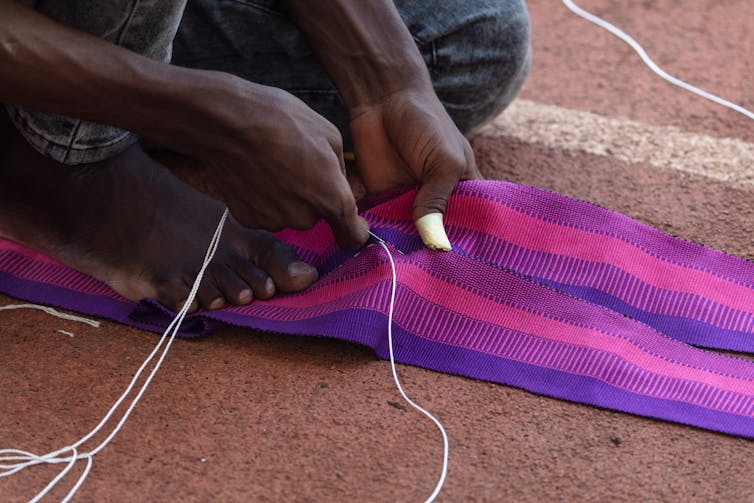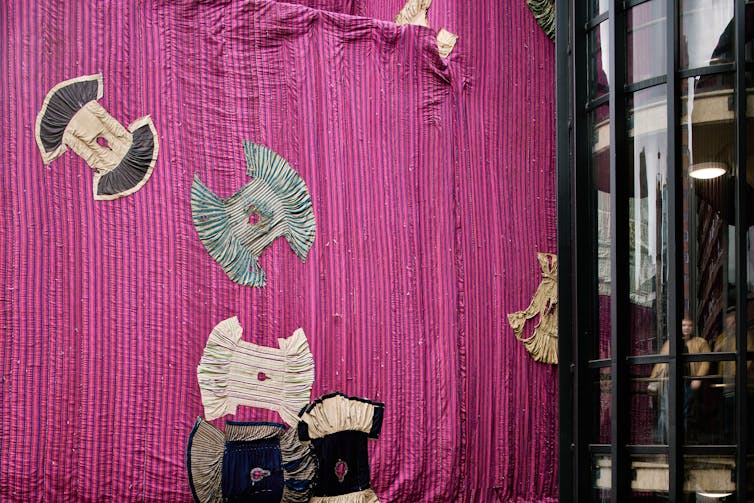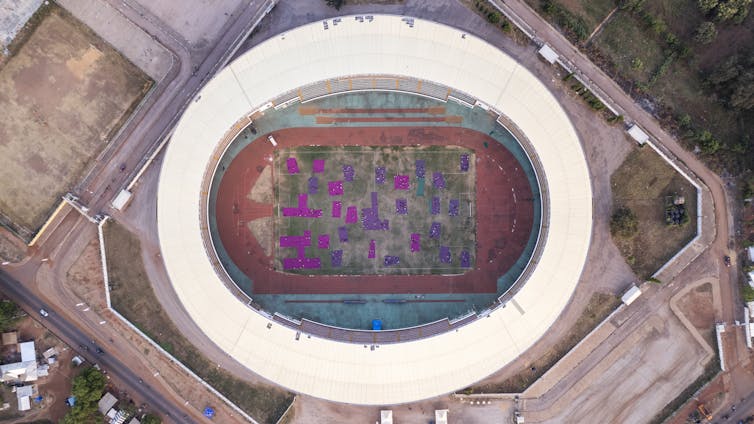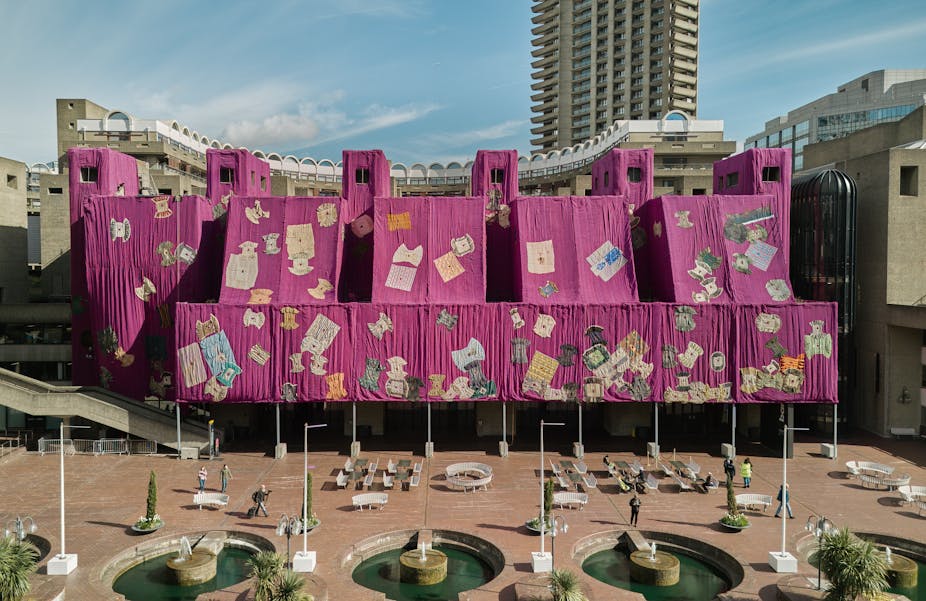The Barbican recently unveiled Purple Hibiscus, a new textile installation by Ghanaian artist, Ibrahim Mahama. Named after Nigerian writer Chimamanda Ngozi Adichie’s 2003 novel, the colourful installation comprises 2,000 square metres of handwoven cloth covering the Barbican’s Lakeside Terrace.
I visited the installation on a cold, windy morning. The bright pink fabric swaying gently in the wind stood in stark contrast to the grey tones of the brutalist architectural complex. However, the visual contrast between the artwork and the building’s concrete façade hides a strong connection.
The handwoven cloth – the creation of which took seven months and employed over 1,000 people – resonates with the enormous human labour that went into building the Barbican. Signs of this labour are visible on the complex’s hand-drilled textured walls.
Speaking to me for this article, Mahama told me: “You never think about the labour that goes into these kind of buildings. You always think: who is the architect that designed this?”

This isn’t the first time Mahama has used textiles to wrap buildings and unravel histories of trade, labour and politics. His previous installations include TRANSFER(S) in Germany (2023), A Friend in Milan (2019), and Out of Bounds at the 56th Venice Biennale (2015). He is mostly known for including cocoa bean jute sacks in his practice as a reference to global trade routes.
However, for the Barbican commission Mahama has departed from the blue and earthy tones of his previous works and instead used pink and purple strips of fabric sewn together with a white running stitch.
Mahama’s signature use of jute sacks and found materials can be compared to the works of Italian artist Alberto Burri and the Arte Povera movement. Arte Povera was an Italian artistic movement that rejected the techniques and materials of the traditional fine arts, in favour of unorthodox and “poor” materials such as soil, iron, rags, plastic and industrial waste.

Mahama is also frequently associated with the artists Christo and Jeanne-Claude, because of their own large-scale temporary installations which envelop public buildings. However, while the artistic duo’s intention was primarily aesthetic, Mahama’s practice extends beyond the form to investigate the historical narratives and production of the material he uses.
Mahama told me that Burri’s “aesthetics and politics of looking at the material” encouraged him to explore the potential for materials to overcome their physical boundaries and stretch into architectural structures.
Transcending boundaries
What I found particularly fascinating about the installation are the 130 batakari (traditional robes from northern Ghana) hand-sewn onto the fabric. They resemble flower-like appliqués.

Batakari are cherished personal possessions, passed down through generations within families. Mahama has been collecting worn batakari from villages in northern Ghana for years, often exchanging them for new smocks.
I reflected on the social lives of the batakari: from being prized possessions in northern Ghana to adorning a brutalist building in central London.
Mahama told me that his interest lies less in the social values attributed to the batakari by people, and more in the evolution of the material itself, with its potential to transcend its physical boundaries. He explained:
The work now will absorb new kinds of values because so many people are going to see it and throw their own interpretations. Once the work goes back to Ghana, it won’t be the same as it was when it left. The batakari from the village has travelled on a ship all the way to England. Many of the people who use this particular garment won’t ever get the chance to come to the UK, yet their objects or their DNA have managed to come to the UK and will eventually return to Ghana again with a very different perspective.
Some of the the batakari incorporated in the installation feature hand-embroidered circular geometric patterns, while others feature typographic characters and stains. Mahama explained that the typographic characters are screen-printed logos on white flour sacks that had been used to make the inner layer of the traditional robes.
In contact with the wearer’s body, the material “absorbs the sweat which becomes evident as stains on the white fabric”. Some of the stains are from urine, deliberately poured on the batakari by their owners as part of a ritual to ward off evil spirits before handing the garment over to the artist.

The batakari exemplify the tension in Mahama’s work between the commodity and the personal. Flour sacks become personal when used as inner layers within the batakari, which are treasured items bearing memories of the wearers.
Reflecting on the batakari now adorning the Barbican’s façade, I am reminded of the anthropologist Igor Kopytoff ’s writings on the cultural biography of things. Kopytoff says that culture and people, by classifying and attributing special meanings to objects, work against the process of commodification of the global economy.
Mahama’s artistic practice seems to resist the process of commodification by highlighting the human stories hidden within trade and ordinary objects, such as jute sacks. Through covering buildings, Mahama uncovers the contradictions and inequalities of this exchange system.
Purple Hibiscus is a fascinating and multilayered contribution to the ongoing Barbican exhibition Unravel: The Power and Politics of Textiles in Art. The pink textile installation highlights once again the deceptive simplicity of textiles and their potential to express peoples’ stories.

Looking for something good? Cut through the noise with a carefully curated selection of the latest releases, live events and exhibitions, straight to your inbox every fortnight, on Fridays. Sign up here.

